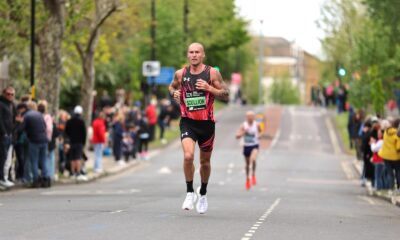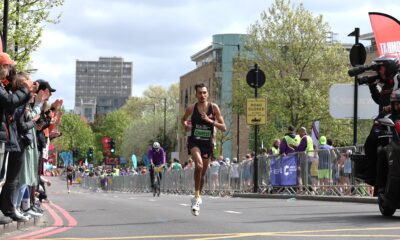
John Beattie is a man who knows a thing or two about success. The Commonwealth Games, World & European XC competitor and owner of Move Better Run Better offers you his five steps to achieving your running goals.
In May 2021 I did something that I would never have predicted a year before… I dragged myself out from being a happily retired former athlete, to being back breaking 30 minutes for 10k and competing with some of the best runners in the UK.
The race was 200 miles away from where I live, so on the long drive back along the non-descript Midlands motorways, I had plenty of time to reflect on that journey of how I went from feeling horribly unfit not that long before, to being able to run 10km at under 3.00 pace, and just how that was able to happen.
I’ve put it down to 5 key steps, all of which I like to think are simple, relatable, non-sciencey, and applicable to anyone who is currently at point A and feeling a long way away from point B where they want to be. I also cannot emphasise enough that you don’t need to be trying to break 30 minutes for 10k for these steps to work, they’ll work regardless of who you are or where you are. The steps are also NOT the SMART goal principals that some of you may have heard on corporate team building days or have been taught at school… boring! So here they are..
Step one: Set the goal and ask why
You wouldn’t just get in a car and drive aimlessly without a destination in mind so why waste time doing that with running? The first thing you need to do is set a target. If you are currently at point A, lets say 4 hour marathon PB, what does point B look like? Is it 3 hours? Replicating your 4 hours from 20 years before? Get clarity on this before going any further.
Once the target is set, the next question to ask yourself is why what you’ve set the target? Peel back the layers of the onion in asking these questions, and don’t just take it at surface level. What is the story beneath the story? When things get tough (which they will do), the stronger you are here the more likely it is that you will overcome the inevitable obstacles.
I wanted to go under 30 minutes for a 13th year in a third different decade, something very few runners will manage in terms of consistency and longevity. I was also desperate to see if after over a year out I could still mix it with some of the best runners in the UK, many who are well over a decade younger than me. When I was starting back and feeling horribly unfit, these were thoughts that kept me excited.
What is your why that is going to get the fire burning? Are you running to make your family proud? To overcome bad past experiences? For a particular person or cause? If you can get to the heart of these, rather than just give a generic vanilla answer, you’ll be in the best possible place to get started
Step two: Getting some help
Trying to do anything meaningful by yourself is a million times harder and will likely takes a heck of a lot of time longer than if you are able to leverage the support of others. Making the most of support, accountability, or specific knowledge, are all things that outsiders can bring. With my sub-30 goal, despite all my many years within running and coaching, I knew I’d need help to make this goal happen and would be wasting my time trying to do it by myself. The two key players I had helping me were my running coach (who masterminded the running plan) and my strength and conditioning coach (who helped keep my body strong and in one piece).
There will be variables involved in this and questions that you’ll need to address. How serious you are about the goal and how important it is in your life? The answers to these questions will determine the level of commitment you are willing to give in terms of investment of time, effort, energy and money. For me, with time being of the essence, I was willing to do whatever it takes on all fronts so got the best help I could from the start.
Who can you bring into your world to put the pieces together to help you work towards the target set in step 1? The biggest advice I can give, is if you are serious about the goal, don’t be one of those people who refuses to accept any help.
Step three: Showing up
If you set yourself a big goal, I won’t BS you, you are going to have to work hard. There will be good days, there will be bad days, there will be days where you feel awful or would prefer to stay indoors. Though, really and not so secretly, the journey rather than the destination itself is the exciting part and getting through the ups and downs is where the growth occurs.
Have you ever heard why the percentage of lottery winners who within a few years lose all their winnings is so high? Its because they haven’t earned that money, they didn’t have to sweat for it, take any risks, and there was no journey involved in getting to the top of the mountain. They were given it without having to work. It’s exactly the same with running – showing up day in day out doing the work is where this will be won or lost, not what happens on race day.
BUT.. Showing up is not about smashing it every single day, or hitting every run for six. Try and do that and it’ll end in burn-out or injury pretty quickly. We want something that is more sustainable for the long haul. This was exactly the approach I took to hit my sub-30. Very few workouts were smashed and celebrated, but crucially very few were completely bombed.
Credit to my coach for pitching them at the right level to. Nearly all of the sessions I’d rate as a 7/10 of box ticked, job done and onto the next day. Grinding out the 7/10s on the days where you are NOT feeling great is how these goals become reality. As mentioned in step 1, connecting with the ‘why’ of the goal will help you on days like these. Adopting a mindset of 7/10 all the way through your training, if you do that then I promise you’ll be good to go on race day
Step four: Being patient
In such a fast-moving world with same day delivery, instant streaming, Amazon, Uber and Just-Eat etc, society is becoming less patient as things become available immediately. People want results straight away and in so many areas are easily able to achieve this now.
Unfortunately, it doesn’t work like that in running and people often get blind-sided to this. For any meaningful goal, results will not be instant. There will be a journey involved, and inevitably the higher the bar the more patience will be required.
I know I’ve talked about the 7/10 rule above, sometimes there’ll be days where you just cant hit this. The days where you’ve had a million other things going on in your life or your body just isn’t up to it that day. When this happens, just move on.
If you feel a world away from the target at the start, it is not the end of the world. When I started on my come back out of retirement, if I’d thought about trying to put together 10km at sub 3.00 pace, I’d of felt miles away, become disinterested and headed to the golf course instead. Initially it really was just getting going again, accepting that it would take time and using benchmarks like ‘can I feel a little better today than I did yesterday’? Can I run a few seconds a mile faster for the same run as last week?
Breaking things down into little micro targets or milestones really helps with this. For me, even running 1km at 3.00 was a real struggle at first, but low and behold by race day I was able to put 10 of them together. What little markers can you use along the way to measure progress towards your goal?
Step five: Backing yourself
If you work your way through the first 4-steps, that gets you to the startline – great. Well done for making it this far.
But you want the icing on the cake, the sweet bit to really enjoy. There is a saying that luck is when preparation meets opportunity and that is exactly it. Once you’ve done the work and the opportunity is in front of you – blooming well back yourself that you can do it.
Once that opportunity is in front of you, yes there will be butterflies, doubts, nerves and yes it will probably hurt along the way – but see this as a good thing. You’ve worked your socks off to get where you have so get out there, detach from the outcome and give your absolute best effort to execute what you’ve prepared so well to do. That really is all you can ask of yourself.
If you make it through these five steps and get the ultimate result on race day then congratulations – its an amazing feeling. I was fortunate enough to have a taste of this when it did come together on the race day – with my 29.43 comfortably inside the initial target.
HOWEVER – If you do give absolutely everything through the journey and on race day, and do fall slightly short of the target, don’t see that as a failure at all – be proud of everything you have given. Were there any lessons you could take? Things you could do differently next time? Recover for another upcoming opportunity?
If my 29.43 had of been 30.04 or 30.29, as long as I knew I’d given my all, it wouldn’t have made any difference to how proud I was of my effort and all the work. It’s so important not to let the outcome define you.
There you go, there are the 5-steps. I told you it wasn’t complicated, it wasn’t sciencey and doesn’t require you to be targeting a sub-30 10k for them to work. As long as you do go through each of the steps properly, carefully, and take the action with each one then you really cant go far wrong.
John Beattie has vast experience as an international athlete and has represented England and Great Britain since as a distance runner on the track, cross country and roads since 2007. For more running advice and inspiration from John, please like and follow the Move Better Run Better Facebook page – www.facebook.com/MoveBetterRunBetter














